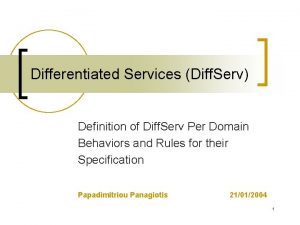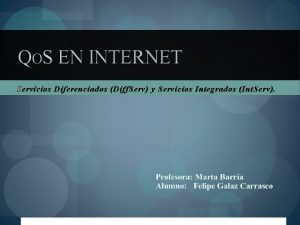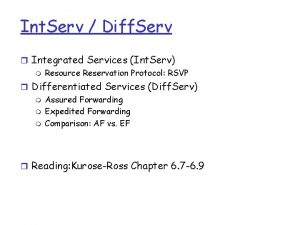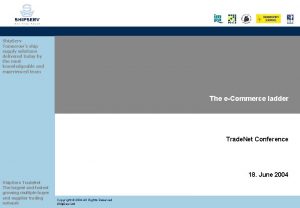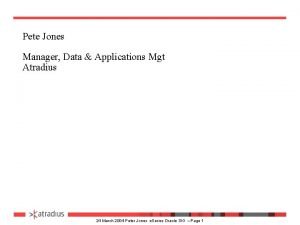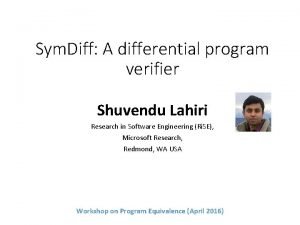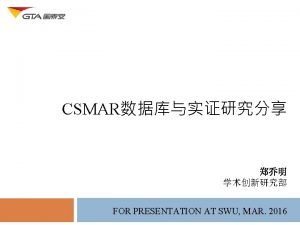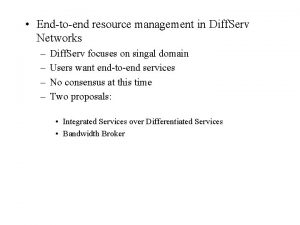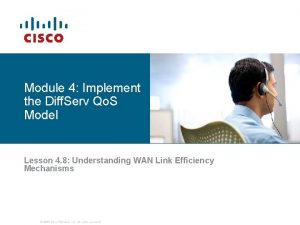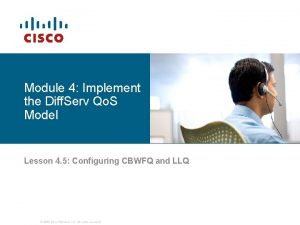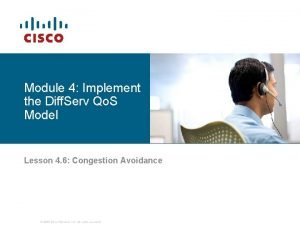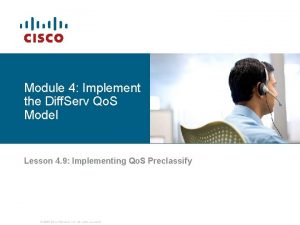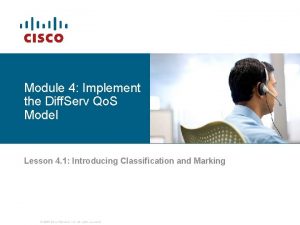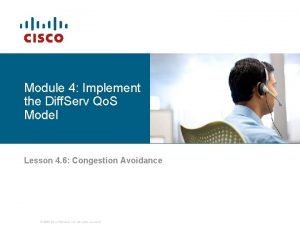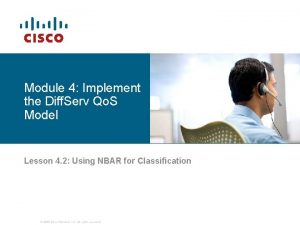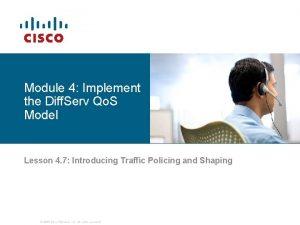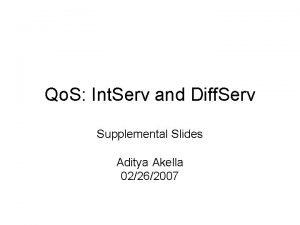Module 4 Implement the Diff Serv Qo S






![NBAR Protocol-to-Port Maps router# show ip nbar port-map [protocol-name] § Displays the current NBAR NBAR Protocol-to-Port Maps router# show ip nbar port-map [protocol-name] § Displays the current NBAR](https://slidetodoc.com/presentation_image_h/76b5536fe824beb4e6b1d9dae9d1119b/image-7.jpg)












- Slides: 19

Module 4: Implement the Diff. Serv Qo. S Model Lesson 4. 2: Using NBAR for Classification © 2006 Cisco Systems, Inc. All rights reserved.

Network-Based Application Recognition My application is too slow! § Used in conjunction with Qo. S classbased features, NBAR is an intelligent classification engine that: Classifies modern client-server and web-based applications Discovers what traffic is running on the network Analyzes application traffic patterns in real time § NBAR functions: Citrix Netshow Fasttrack FTP HTTP 25% 10% 30% 20% Sample Link Utilization © 2006 Cisco Systems, Inc. All rights reserved. Performs identification of applications and protocols (Layer 4– 7) Performs protocol discovery Provides traffic statistics § New applications are easily supported by loading a PDLM.

NBAR Functions & Features § NBAR performs the following two functions: Identification of applications and protocols (Layer 4 to Layer 7) Protocol discovery § Some examples of class-based Qo. S features that can be used on traffic after the traffic is classified by NBAR include: Class-Based Marking (the set command) Class-Based Weighted Fair Queueing (the bandwidth and queue-limit commands) Low Latency Queueing (the priority command) Traffic Policing (the police command) Traffic Shaping (the shape command) © 2006 Cisco Systems, Inc. All rights reserved.

NBAR Application Support § NBAR can classify applications that use: Statically assigned TCP and UDP port numbers Non-UDP and non-TCP IP protocols Dynamically assigned TCP and UDP port numbers negotiated during connection establishment (requires stateful inspection) Subport and deep packet inspection classification © 2006 Cisco Systems, Inc. All rights reserved.

Packet Description Language Module § PDLMs allow NBAR to recognize new protocols matching text patterns in data packets without requiring a new Cisco IOS software image or a router reload. § An external PDLM can be loaded at run time to extend the NBAR list of recognized protocols. § PDLMs can also be used to enhance an existing protocol recognition capability. § PDLMs must be produced by Cisco engineers. © 2006 Cisco Systems, Inc. All rights reserved.

PDLM Command Syntax router(config)# ip nbar pdlm-name § Used to enhance the list of protocols recognized by NBAR through a PDLM. § The filename is in the URL format (for example, flash: //citrix. pdlm). router(config)# ip nbar port-map protocol-name [tcp | udp] port-number § Configures NBAR to search for a protocol or protocol name using a port number other than the well-known port. § Up to 16 additional port numbers can be specified. © 2006 Cisco Systems, Inc. All rights reserved.
![NBAR ProtocoltoPort Maps router show ip nbar portmap protocolname Displays the current NBAR NBAR Protocol-to-Port Maps router# show ip nbar port-map [protocol-name] § Displays the current NBAR](https://slidetodoc.com/presentation_image_h/76b5536fe824beb4e6b1d9dae9d1119b/image-7.jpg)
NBAR Protocol-to-Port Maps router# show ip nbar port-map [protocol-name] § Displays the current NBAR protocol-to-port mappings router#show ip nbar port-map port-map port-map bgp udp 179 bgp tcp 179 cuseeme udp cuseeme tcp dhcp udp 67 dhcp tcp 67 dns udp 53 dns tcp 53 © 2006 Cisco Systems, Inc. All rights reserved. 7648 7649 68 68

NBAR Protocol Discovery § Analyzes application traffic patterns in real time and discovers which traffic is running on the network § Provides bidirectional, per-interface, and per-protocol statistics § Important monitoring tool supported by Cisco Qo. S management tools: Generates real-time application statistics Provides traffic distribution information at key network locations © 2006 Cisco Systems, Inc. All rights reserved.

Configuring and Monitoring NBAR Protocol Discovery router(config-if)# ip nbar protocol-discovery § Configures NBAR to discover traffic for all protocols known to NBAR on a particular interface § Requires that CEF be enabled before protocol discovery § Can be applied with or without a service policy enabled router# show ip nbar protocol-discovery § Displays the statistics for all interfaces on which protocol discovery is enabled © 2006 Cisco Systems, Inc. All rights reserved.

Configuring and Monitoring Protocol Discovery Output router#show ip nbar protocol-discovery Ethernet 0/0 Input Protocol Packet Count Byte Count 5 minute bit rate (bps) -----------------realaudio 2911 1678304 19000 http 19624 14050949 0 <output omitted> © 2006 Cisco Systems, Inc. All rights reserved. Output Packet Count Byte Count 5 minute bit rate (bps) ------------3040 198406 1000 13506 2017293 0

Steps for Configuring NBAR for Static Protocols § Required steps: Enable NBAR Protocol Discovery. Configure a traffic class. Configure a traffic policy. Attach the traffic policy to an interface. Enable PDLM if needed. © 2006 Cisco Systems, Inc. All rights reserved.

Configuring NBAR for Static Protocols Commands router(config-cmap)# match protocol § Configures the match criteria for a class map on the basis of the specified protocol using the MQC configuration mode. § Static protocols are recognized based on the well-known destination port number. § A match not command can be used to specify a Qo. S policy value that is not used as a match criterion; in this case, all other values of that Qo. S policy become successful match criteria. © 2006 Cisco Systems, Inc. All rights reserved.

Configuring NBAR Example § HTTP is a static protocol using a well-known port number 80. However, other port numbers may also be in use. § The ip nbar port-map command will inform the router that other ports are also used for HTTP. © 2006 Cisco Systems, Inc. All rights reserved.

Steps for Configuring Stateful NBAR for Dynamic Protocols § Required steps: Configure a traffic class. Configure a traffic policy. Attach the traffic policy to an interface. © 2006 Cisco Systems, Inc. All rights reserved.

Enhanced NBAR Classification for HTTP router(config-cmap)# match protocol http url-string § Recognizes the HTTP GET packets containing the URL, and then matches all packets that are part of the HTTP GET request § Include only the portion of the URL following the address or host name in the match statement router(config-cmap)# match protocol http hostname-string § Performs a regular expression match on the host field content inside an HTTP GET packet and classifies all packets from that host © 2006 Cisco Systems, Inc. All rights reserved.

Special NBAR Configuration for HTTP and Fast. Track router(config-cmap)# match protocol http mime MIME-type § Matches a packet containing the MIME type and all subsequent packets until the next HTTP transaction for stateful protocol. router(config-cmap)# match protocol fasttrack file-transfer regular-expression § Stateful mechanism to identify a group of peer-to-peer file-sharing applications. § Applications that use Fast. Track peer-to-peer protocol include Kazaa, Grokster, Gnutella, and Morpheus. § A Cisco IOS regular expression is used to identify specific Fast. Track traffic. § To specify that all Fast. Track traffic will be identified by the traffic class, use asterisk (*) as the regular expression. © 2006 Cisco Systems, Inc. All rights reserved.

URL or HOST Specification String Options Description * Match any zero or more characters in this position. ? Match any one character in this position. | Match one of a choice of characters. (|) Match one of a choice of characters in a range. For example, xyz. (gif | jpg) matches either xyz. gif or xyz. jpg. [ ] Match any character in the range specified, or one of the special characters. For example, [0 -9] is all of the digits; [*] is the "*" character, and [[] is the "[" character. © 2006 Cisco Systems, Inc. All rights reserved.

Configuring Stateful NBAR for RTP router(config-cmap)# match protocol rtp [audio | video | payload-type payload -string] § Identifies real-time audio and video traffic in the class-map mode of MQC § Differentiates on the basis of audio and video codecs § The match protocol rtp command has these options: audio: Match by payload type values 0 to 23, reserved for audio traffic video: Match by payload type values 24 to 33, reserved for video traffic payload-type: Match by a specific payload type value; provides more granularity than the audio or video options © 2006 Cisco Systems, Inc. All rights reserved.

Classification of RTP Session © 2006 Cisco Systems, Inc. All rights reserved.
 Serv definition
Serv definition Servicios diferenciados
Servicios diferenciados Diff in diff regression
Diff in diff regression Apa serv alexandria
Apa serv alexandria Int serv
Int serv Brutus remote password cracker
Brutus remote password cracker Global trade repository
Global trade repository Ship serv
Ship serv Expektoráció jelentése
Expektoráció jelentése Atradius serv net
Atradius serv net C device module module 1
C device module module 1 Sym.diff
Sym.diff Schottky defect
Schottky defect Azumith
Azumith Splunk doc
Splunk doc Data structure classification
Data structure classification Chain and compass survey
Chain and compass survey Difference between sympathetic and parasympathetic
Difference between sympathetic and parasympathetic Inverse tan derivative
Inverse tan derivative Avg diff
Avg diff
